Tibetan Prayer Flags
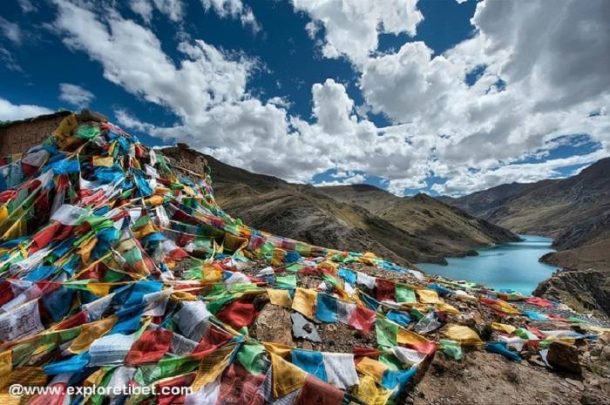
Tibetan Prayer Flags
Traditionally, prayer flags are colorful rectangular pieces of cloth that are used to give blessings to the countryside, as well as in many forms of Tibetan Buddhist prayers. A common misconception among non-Buddhists is that prayer flags carry the prayers of the people to the gods. This is not true. Tibetan people believe that the wind will blow their prayers and mantras out into the surrounding countryside, to spread their goodwill and compassion to all things.
History of the Prayer Flag
While most legends attribute the use of prayer flags to the Gautama Buddha, in Tibet, prayer flags originate in the pre-Buddhist religion of the region, now known as Bön, which can still be found in small groups in parts of western Tibet. The actual roots of prayer flags are believed to have been influenced by the Indian Hindu tradition of writing sutras on clothes and brought to Tibet long before the practice of Buddhism was introduced to the region. In ancient Bön, the shamanistic Bönpo used prayer flags in the primary colors in Tibet to honor their gods of nature. These traditional prayer flags often included text and images printed using primitive woodblock carved with the words and pictures.
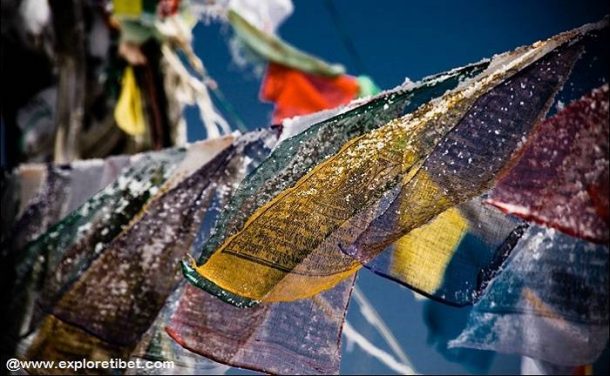
Traditional Tibetan Prayer Flags
This has given rise to the colors used in Tibetan Buddhism today, and prayer flags come in sets of five colors. Each of the five colors represents one of the five elements in Tibetan Buddhism, and hanging the prayer flags should be done in a specific order: blue, white, red, green, and yellow. In traditional Tibetan medicine, these five elements are balanced to produce health and harmony in the body and mind.
The meaning of each of the colors used to represent the different elements are:
Blue – for the sky or space
White – for the air and the clouds
Red – for fire
Green – for water
Yellow – for the earth
Types of Prayer Flags
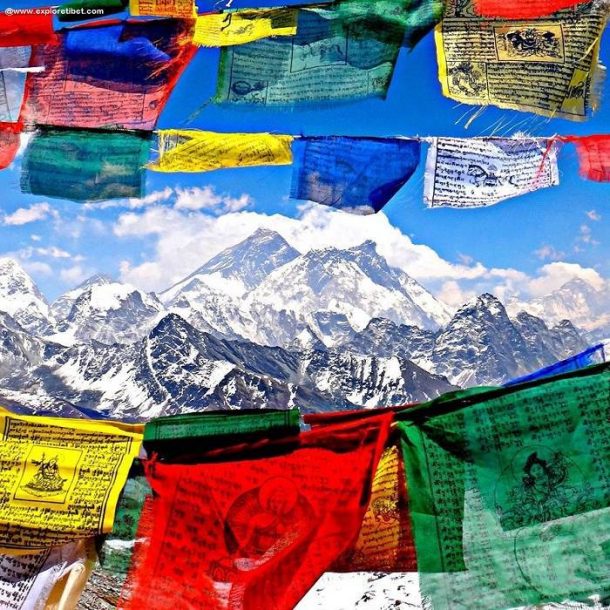
Lung-Ta or “Wind Horse” Prayer Flags
There are two basic kinds of prayer flags that are used in Tibetan Buddhism today, horizontal and vertical. The horizontal flags, known as Lung-ta or “Wind Horse”, are either square or rectangular and are strung along the longest edge in a row between two high points or a high point and the ground. These are the most often seen kind of prayer flags in Tibet, and can often be found at high mountain passes, sacred religious sites, monasteries and temples, and along the side of the road.
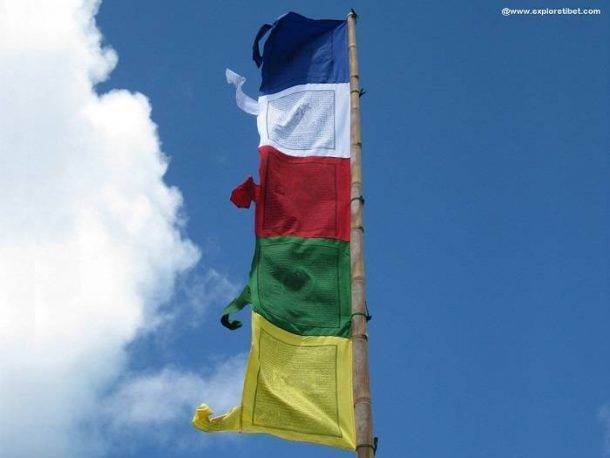
Darchog or “Flagstaff” Prayer Flags
The vertical flags, known as Darchog or “flagstaffs”, are more flag-like in their flying, and are rectangles of cloth attached to poles along the shorter edge. The poles are then embedded in the ground to allow the flag to stand upright, hence the name “Flagstaff”. Mostly found at very sacred religious sites, mountains, and on rooftops of monasteries and temples, these iconographic flags are symbolic of the Vedic traditions of Dhvaja, a banner or flag that contains the eight auspicious symbols in Hinduism.
In the center of a prayer flag, there is traditionally an image of a horse carrying three flaming jewels. Around the horse and jewels there are mantras dedicated to a particular deity, and often include mantras from the great Buddhas, Guru Rinpoche, Chenrezig, and Majusri. The corners of the flags are adorned with the images of four animals, known as the “Four Dignities”, and are the dragon, the garuda, the tiger, and the snowlion.
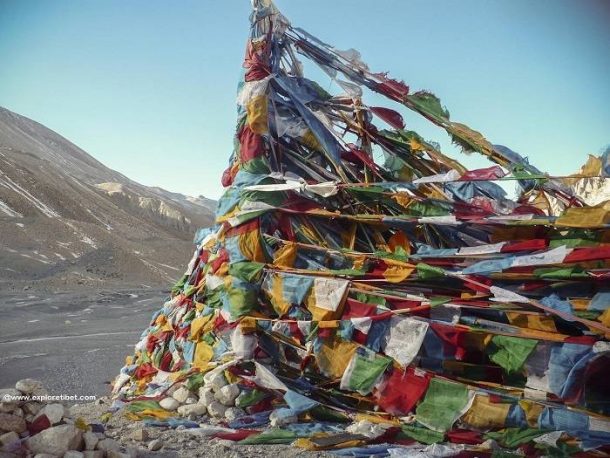
New Prayer Flags strung over and next to old ones
As these flags are hoisted into the air or attached to their string, to promote wisdom, peace, strength, and compassion, they are believed to bring benefit to all. As the wind passes over the flags, it is believed that the air is sanctified and purified by the mantras and images on the flags. It is also believed that, as the images and mantras fade from view, the flag has become an integral part of the universe, and is symbolic of the passing of all things eventually. Tibetans continuously hang new prayer flags next to the old ones to renew their hopes for the good of the people and the world. While it can seem like the prayer flags you see hanging from the mountain passes and lakesides are never taken down, there are times when they are, usually only at the time of the Tibetan New year, when they are replaced with new ones. Those that are taken down must be treated with respect and not be put on the ground. Once taken down, they are held off the ground, and are then burned, to allow the remaining essence of their sanctity to blow away on the smoke.
When to hang Prayer Flags
Hanging a prayer flag can usually be done on any date, although traditionally you should ensure that the date is not an inauspicious one, and not a bad astrological date, or even just on a bad day for you. It is believed that when hung on a bad day, they will carry bad tidings into the air that will affect many people and animals. Weather-wise, the best days to hang prayer flags are early in the morning on windy yet sunny days, as it is believed that the bright sun can bring out the good moods of the people hanging the flags, and the winds start to carry the blessings as soon as they are hung.
Where to see Prayer Flags
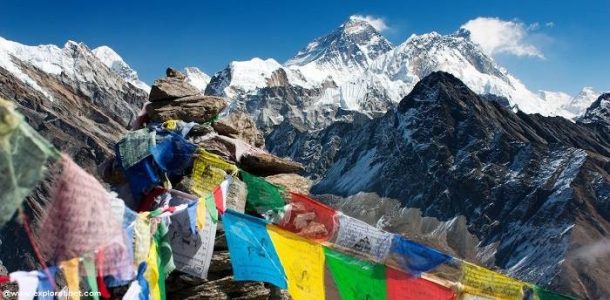
Prayer flags at Mount Everest Base Camp
While you can hang prayer flags almost anywhere, and you will find them in many places across the region, including Mount Everest Base Camp, there are also traditional places where people will hang them, and these sites can be found all across Tibet, from the streets of Lhasa to the far west of Tibet.
Dolma-La Pass
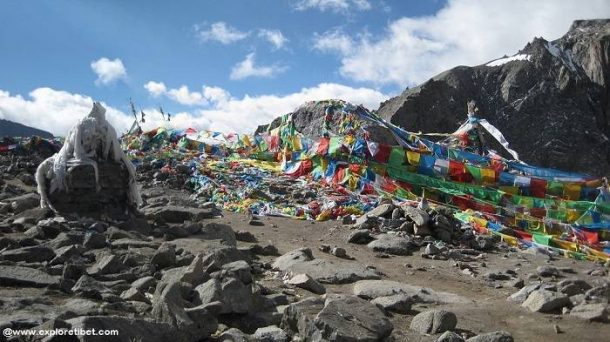
Prayer Flags at Dolma La Pass, Mount Kailash Kora
Dolma La is the Tibetan name of Goddess Parvati, wife of Lord Shiva residing at Mount Kailash.
The pass can be treacherous if the weather is not favourable. It is said that one can cross only if Goddess Dolma allows you to. Today, she was kind enough to bestow her blessings and we crossed the pass with no hindrance at all.
We were warned not to linger around for too long at this altitude for the air is very thin here. We only spent a few moments at the top of the pass and quickly hurried down towards Gauri Kund.
Lying on the route of the sacred kora around Mount Kailash in Ngari Prefecture of Western Tibet, the Dolma-La Pass is a popular place for pilgrims to hang prayer flags. As you reach the top of the pass, at an altitude of around 5,636 meters, you can see the flags strewn across the pass and on down the trail some way. The crossing of the pass is believed to represent the passing from one life into the next, and all the sins of the former life are forgiven. In the midst of the pass, there is a large rock known as the Phawang Mebar, on which a pole stands for people to attach their prayer flags.
Lake Namtso
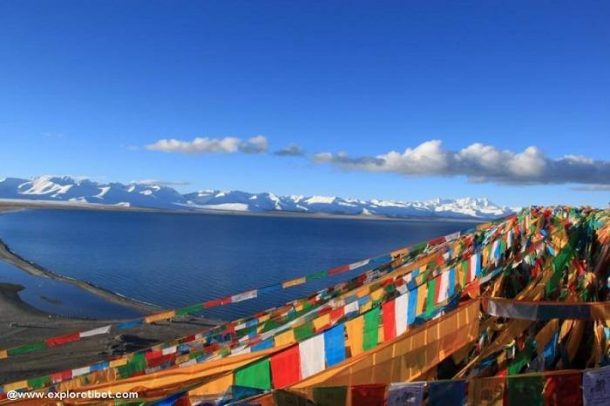
Prayer Flags at Lake Namtso
One of the Great Three Lakes of Tibetan Buddhism, Lake Namtso has areas of its surroundings that are festooned with prayer flags. One of the sacred sites in Tibetan Buddhism, it is a popular place for pilgrimage, and the kora route around the lake is dotted with sites where prayer flags have been put up by the thousands of pilgrims that come to the lake to pray and walk the kora route.
Recent Posts
The Ultimate Guide to Tibet Tours, Travel, and Trekking Adventures
How to Explore Tibetan Culture
Exploring Lhasa:The Heart of Tibet
All Categories
- About Tibet
- book a Tibet tour
- Buddhism Practice
- Budget Tour
- China-Tibet Train
- Customized Tibet tour
- Historical Sites
- Hot Springs in Tibet
- News
- Photography in Tibet
- Tibet attraction
- Tibet Group Visa
- Tibet Motorcycle Tour
- Tibet Small Group Tours
- Tibet Tours and Tibetan Tour Guide
- Tibet Train
- Tibet Travel FAQs
- Tibet Travel Information
- Tibet Travel News
- Tibet Travel Permit Update
- Tibet Travel Prices Rises
- Tibet Trek
- Tibet Trekking Tour
- Tibet weather and climate
- Tibet Wildlife animals
- Tibet Winter Tour
- Tibetan Buddhism
- Tibetan Cultural Features
- Tibetan Culture and Poeple
- Tibetan Festivals
- What to see in Tibet



